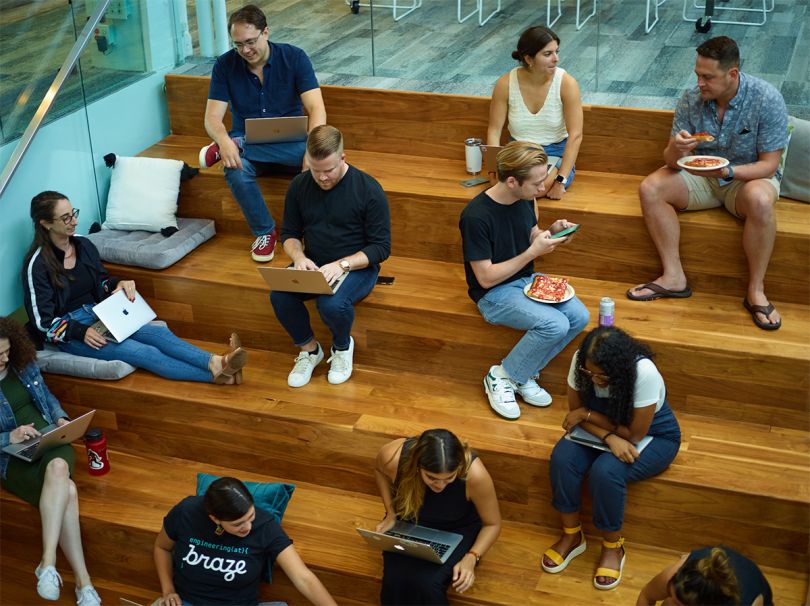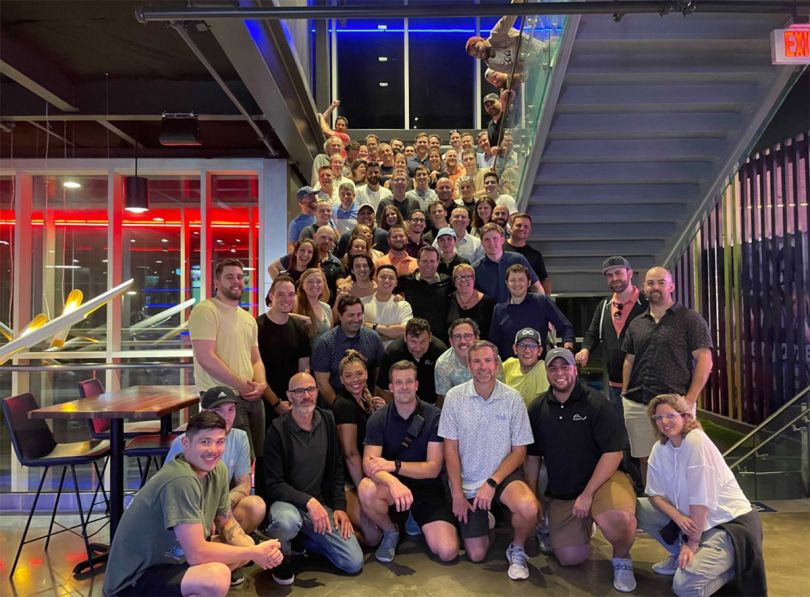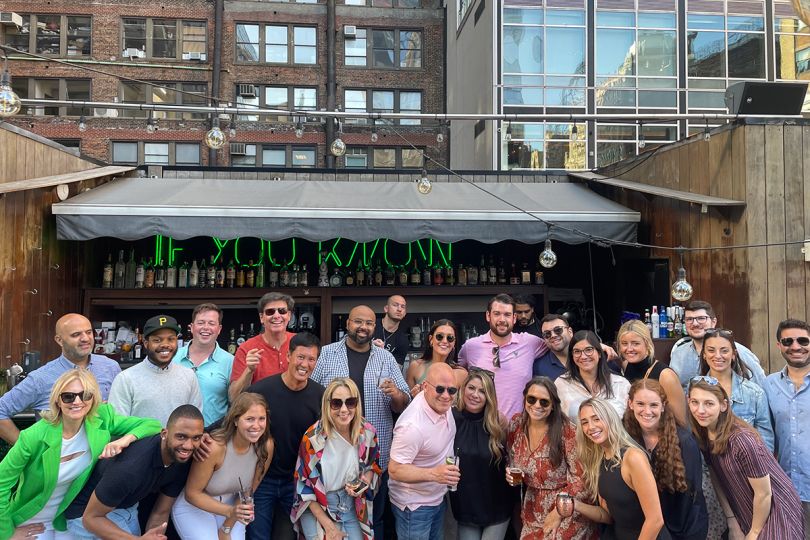At many companies, it now seems to be a given: hybrid and remote models are here to stay. Despite some challenges that virtual work brings, these five New York-based companies are excited to be at the forefront of crafting flexible work environments where people feel engaged and empowered.
Though there are differences in the details of their individual work models, these featured companies subscribe to some common ideas — mainly, they care deeply about their people and teams, and they believe in the ability to choose where one does their best work. For some employees, that means working from home, while others log on from a co-working space, the New York office or while traveling.
As a result of embracing flexibility, companies say they are reaping significant benefits such as higher employee satisfaction, lower attrition rates and increased productivity.
“When you empower employees to choose how they approach their tasks, there’s a clear message from the company that individuals are heard and their needs are addressed,” said Shanee Kraus, head of employee community at Augury.
For recruitment leaders, an additional perk is no longer being bound by geography, as they are free to find the best talent from anywhere in the country, or sometimes even the world.
Still, these companies are open and honest about the challenges that come with adopting remote work structures, such as fostering community among employees dispersed across time zones. In response, they strategically use virtual platforms to build belonging through employee resource groups, one-on-one meetings, Slack channels, happy hour events and more. Their leaders also recognize the value of face-to-face connection and organize fun and engaging in-person opportunities for professional development, social connection and community involvement.
Built In New York connected with leaders from Braze, Kin + Carta, Augury, DeepIntent and Spruce to learn more about how they navigate the exciting frontier of building positive hybrid and remote work cultures.

At Braze, a customer engagement platform for brands, each department enjoys a unique work model — some mostly in person, others remote-first or hybrid — depending on their roles and the type of collaboration that works best for the team.
A major benefit of Braze’s flexible work models, according to Senior People Business Partner Mallory Anderson, was expanding their talent pools beyond cities with their physical office spaces. On the flip side, a challenge is building company culture, which Braze nurtures through employee resource groups, fun virtual events including drag queen bingo and happy hours, and engaging learning opportunities such as speaker series and hackathons.
What does your company’s hybrid/remote work model look like?
Our goal at Braze is to harmonize the needs of the business and the needs of our employees with the way we work. We opted against a one-size-fits-all work model. Each department at Braze has unique needs and priorities, so they are empowered to help guide employee expectations as we look toward the future.
In practice, some of our teams — including research and development functions and global shared services — have minimal in-office requirements, where employees never have to come to an office but are free to do so as they choose. Others — including general and administrative functions, customer success and marketing — primarily work remotely but come together at the office periodically throughout the month. When our sales organization and its key counterparts are not in the field, they’re working in the office the most frequently. They’ve found that in-person collaboration and mentorship is an invaluable resource to team members.
What’s the greatest benefit your company has seen from transitioning to a hybrid/remote model?
One of the best benefits was several of our departments widening their talent pools beyond just the cities where we have offices. Don’t get me wrong, we have a lot of really amazing offices — including in San Francisco, Chicago, Austin, Paris, New York City, London, Berlin, Tokyo and Singapore — but since expanding our searches, we’ve hired incredible employees in other regions that helped make Braze an even more dynamic place to work. We have a sizable group of Denverites, a large crew in Los Angeles and a growing force in Indianapolis, among many other places.
When you have employees distributed all over the globe, you have to work very intentionally to build team bonds and keep people engaged.”
What’s one challenge you encountered while implementing a hybrid/remote model, and how did your company overcome it?
When you have employees distributed all over the globe, you have to work very intentionally to build team bonds and keep people engaged. Our employee experience team and employee resource groups are dedicated to providing programming, both in person and virtually, to help employees get to know each other and find their group at Braze.
We have a lot of fun, from drag bingo to new-hire happy hours. We learn together, from speaker series events to hackathons. We celebrate our accomplishments and milestones across the globe, and we aim to do it all in a way that is inclusive of our entire employee population, regardless of where they work.
At Kin + Carta, an agency that uses digital strategies to solve companies’ challenges, employees — whom the company calls “Kin” — are empowered to choose the work model that best meets their needs. While the majority of Kin work remote-first, they are able to meet up with colleagues for co-working and social opportunities through the agency’s “hub and cluster” system in popular cities.
Leaders say a great benefit of the altered work model is the flexibility it allows for both employees and the business, while a challenge is fostering a sense of belonging in the workplace. In addition to its hub and cluster system, Kin + Carta is working to maintain a positive company culture through initiatives by several teams including the employee value proposition team, internal culture committees and a volunteer-led culture and connectedness group.
What does your company’s hybrid/remote work model look like?
We implemented work types inclusive of remote, hybrid and in-person models. Our employees, whom we refer to as “Kin,” are empowered to opt in to the type that best suits their current needs. While the majority of our Kin elected to work remotely, they also shared that opportunities for connection and feeling a sense of belonging at work are critical to their success.
This is where our regional offices and our focus on the firm’s employee value proposition made big impacts. In our eastern region, we have one of the most distributed workforces. In order to support the geographic distribution of our East Kin, we piloted a “hub and cluster” model. Our “hubs” are locations where we have the highest concentration of Kin and our “clusters” are where we have a growing number of Kin.
Our hub in the eastern region is New York City, where we host frequent opportunities for co-located work and in-person connection through social and volunteer opportunities. Clusters of Kin coordinate local co-working and connection opportunities on a smaller scale and operate as another landing pad for traveling Kin.
What’s the greatest benefit your company has seen from transitioning to a hybrid/remote model?
The greatest benefit to hybrid work is flexibility, both for individuals and for businesses. At Kin + Carta, we found new and better ways to support employees, explore new work models and grow our workforce beyond a single location. In our eastern region, the hub and cluster model provided flexibility to respond quickly to the needs of our Kin.
Currently, we are focused on holistically supporting our growing and increasingly distributed workforce. In the Washington, D.C., area specifically, we’ve had significant growth in the past year. As the cluster emerged, local Kin created a Slack channel for chatter. Over the past few months, it became increasingly organized with regularly scheduled co-working opportunities and events, representation on our internal committees and support from our leadership. Washington, D.C., is just one example, but other clusters are following a similar trajectory.
At Kin + Carta, we found new and better ways to support employees, explore new work models and grow our workforce beyond a single location.”
What’s one challenge you encountered while implementing a hybrid/remote model, and how did your company overcome it?
Like many companies, Kin + Carta is navigating the challenge of driving connection and fostering a sense of belonging because they are key to workplace satisfaction. Our offices and co-working spaces create centers of gravity and opportunities for connection for those who make the commute. However, as our Kin relocate, we also have a need to serve those who do not visit these spaces regularly.
We are actively addressing this through several angles. At the Americas’ level, we organized a team dedicated to our employee value proposition. We’re currently focused on enhancing internal processes to strengthen bonds between our Kin and further areas of our business that make Kin + Carta a great place to work and grow. As we operate within a hybrid, remote-forward space, we’ve also expanded the charge of our internal culture committees.
In the east, our volunteer-led culture and connectedness group is made up of people who are passionate about connection in a hybrid work environment. They create unique opportunities to get to know colleagues virtually and in person, whether they work down the street or several states away.

For Augury, an AI-powered machine health solutions provider, employees in Israel choose to work remotely or in their Haifa and Tel Aviv offices, while U.S. workers log on from home or a local company-funded co-working space.
While operating in their “blended work environment,” Augury leaders say they’ve seen productivity rise as a result of employees having the autonomy to decide where they do their best work. As the company grows, leaders found that a challenge was onboarding new employees virtually to ensure they feel connected to the workplace. In response, Augury developed a human-first approach to virtual onboarding, creating opportunities for new hires to engage in one-on-ones with managers and individual contributors.
What does your company’s hybrid/remote work model look like?
Augury has two main locations in Israel and the United States. While both teams work closely together, the hybrid approach is different. In Israel, employees can either work from home or from our offices in Haifa or Tel Aviv. In the United States, we offer employees the option to work from home or from a co-working space of their choice funded by the company close to home. At Augury, we understand that our work environment has a direct impact on employees’ motivation, creativity, well-being and efficiency, and we want to provide our employees the flexibility they need.
The decision to work in a hybrid environment impacts our physical offices. This is the pure essence of hybrid; it’s not just about the individual’s decision to either work remotely or at the office. It’s a company having different employees attend the same meetings from different locations, for example, and the physical space needs to cater to and embrace that.
We use the term “blended work environment,” which is a mixed approach to work happening at the same time in physical and digital spaces. It’s where all individuals feel part of the work environment, included, heard and empowered to choose how they work.
At Augury, we understand that our work environment has a direct impact on employees’ motivation, creativity, well-being and efficiency.”
What’s the greatest benefit your company has seen from transitioning to a hybrid/remote model?
When you provide employees with the flexibility of choosing how, when and from where they work, we’ve seen different positive outcomes. Productivity is one. When you empower employees to choose how they approach their tasks, there’s a clear message from the company that individuals are heard and their needs are addressed.
For example, when an employee can choose to work in a quiet setting rather than in a noisy open-space environment, they are more productive when completing deep-focus tasks. This is not only because the setting is more accommodating, but also because they are more motivated when their needs are seen and addressed.
What’s one challenge you encountered while implementing a hybrid/remote model, and how did your company overcome it?
I think one of the greatest challenges of this new norm brought to us by COVID-19 is the need to onboard new employees virtually. During the past two years, Augury went through a period of hyper-growth, doubling the number of its employees. How do you onboard so many people in this hybrid environment? How do you get people to feel like they belong when you don’t always have the option of going to the office to meet your peers and managers?
Again with the notion of people first, Augury developed a virtual onboarding program focused heavily on human interactions. Yes, we can’t meet in person, but we are prioritizing one-on-one meetings between new hires and different people across the company, such as managers and individual contributors. This creates an immediate connection and relatedness to different people.
An organization can use the most advanced technology and tools out there, but it has to have the empathy to use it in a way that helps its employees, especially in those fragile situations and moments such as during your first few months working at a company.

DeepIntent, a healthcare advertising agency, leads with a remote-first model that encourages employees to meet in person for company events and quarterly meetings.
With the company embracing a flexible model, leaders found that geography was no longer a limiting factor, as they were able to recruit talent far outside the commutable distance to their Midtown Manhattan office. With greater flexibility, remote work can often pressure employees into feeling like they need to always be online or available to their colleagues. At DeepIntent, however, Vice President of Operations Chris Meyer says the company prioritizes recharging and disconnecting, as they encourage employees to set clear expectations about their availability and go offline outside those hours.
What does your company’s hybrid/remote work model look like?
I would describe our approach as a remote-first work model. Our employees are free to live and work wherever they feel comfortable within the country, with no requirement to work from our office on a regular basis. While we still value in-person interactions and encourage people to attend company events and quarterly meetings in the office, we provide our employees with the flexibility to decide what works best for them.
To make this model work successfully, you must trust your employees to manage their workload responsibly and meet client deliverables reliably.
To make this model work successfully, you must trust your employees to manage their workload responsibly and meet client deliverables reliably.”
What’s the greatest benefit your company has seen from transitioning to a hybrid/remote model?
Embracing a flexible approach allowed us to find great talent throughout the country. Previously, we focused on hiring people in the New York area who could commute to our Midtown Manhattan office on a regular basis. Now, we have employees living and working in more than 20 states.
For most open roles within the company, geography no longer needs to be a limiting factor. With a national talent network, we can continue to scale quickly and attract the best in our industry to join the company.
What’s one challenge you encountered while implementing a hybrid/remote model, and how did your company overcome it?
When working in a remote/hybrid model, it’s easy to feel obligated to always be online, even outside normal business hours, and to be immediately available to your colleagues. For this reason, we encourage people to set expectations about their availability and take enough time off to disconnect. Something as simple as updating your status on Slack provides the necessary space to be offline and recharge. You can’t be at your best when you feel burnt out from overworking.

For employees at Spruce, a digital real estate transactions platform, choosing where to work is a personal decision. Leaders call their model “location agnostic” — meaning they believe people can do great work from any location, and co-working spaces are mainly utilized as a means to boost team morale and complete necessary in-person tasks.
After implementing this model, Spruce leaders identified employee satisfaction and engagement as the greatest benefits — with 96 percent of employees agreeing or strongly agreeing that Spruce was a flexible workplace, according to the company’s annual survey. With employees now able to run errands during the work day or log on while visiting family, however, Vice President of People Operations Emily Katz found that employees weren’t taking enough time off from work to disconnect. In response, Spruce altered its PTO benefits to a generous accrued policy with an expectation that employees take off at least five consecutive days annually.
What does your company’s hybrid/remote work model look like?
Spruce’s operating model is location agnostic. For us, this means finding the right person for each role and supporting them to do a great job no matter where they are geographically. We use co-location strategically, whether it’s an in-person job or a team traveling to gather face to face. For us, most co-location is for morale and team building and to complete any necessary in-person tasks. We look at the impact of our employees’ work first and foremost, and we use getting together as an optional way to support their connection and well-being.
While local employees are free to come in and work together in our New York City office, our primary connection to each other is online through Slack, video calls, team engagement events and activities. Where to work is a largely personal decision, so our office is intended to be a welcoming, secondary workspace for those who enjoy using it. We give employees plenty of space to discover the right balance with their colleagues, supporting how each person works best instead of encouraging one right way for everyone.
We give employees plenty of space to discover the right balance with their colleagues, supporting how each person works best instead of encouraging one right way for everyone.”
What’s the greatest benefit your company has seen from transitioning to a hybrid/remote model?
Employee satisfaction and engagement are the greatest benefits. We understand that flexibility at work is a priority for many people. In our annual engagement survey, 96 percent of our employees agreed or strongly agreed that Spruce was a flexible place for them to work. Based on employee comments, our approach to location contributed significantly to that score.
Employees have the space at Spruce to work where they are, often fitting in personal tasks during the day or enjoying an extended stay away from home to see relatives or explore. We see the low attrition, high job satisfaction and dedication folks have to our mission, in part, as a privilege we’ve earned through trust and respect for our employees’ ability to do a great job wherever they are.
What’s one challenge you encountered while implementing a hybrid/remote model, and how did your company overcome it?
When Spruce officially adopted a location-agnostic operating model, we quickly found that employees did not take enough time away from work. We observed that median PTO utilization was less than two weeks a year, despite an unlimited PTO and sick time policy. Talking with employees, many reported that, when working from home, they felt they didn’t need to take the afternoon off to accept a delivery or do school pickup, or even to travel. While employees may balance these responsibilities with a work day, we still feel like it is important for employees to truly disconnect, rest and recharge.
In response to what we learned in the first few months, we changed out PTO policy from unlimited to a generous accrued policy (four weeks in the first year and five weeks thereafter, plus sick time) with a stated expectation that employees take off at least five working days in a row at some point during the year. We wanted our employees to know that while they could work from anywhere, they were also entitled and encouraged to take real vacations as well.














